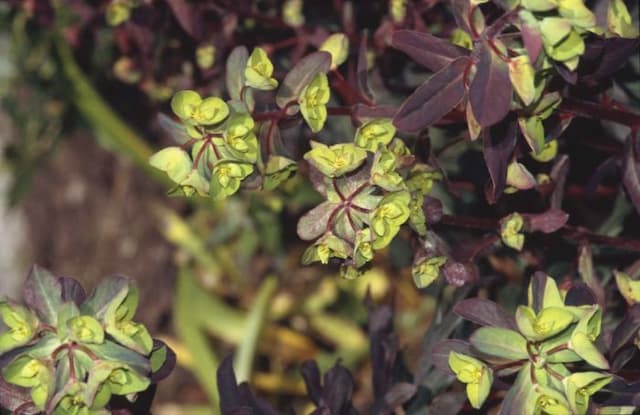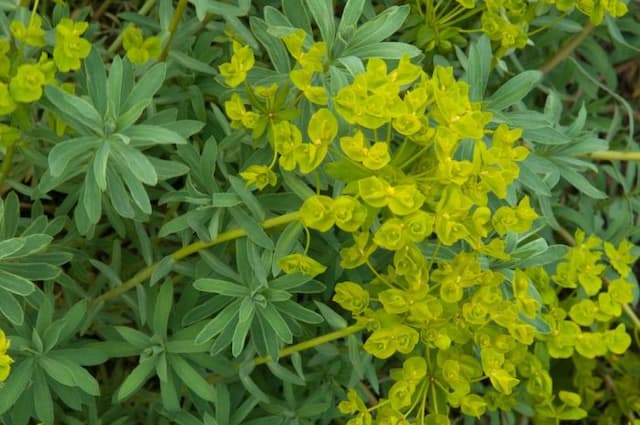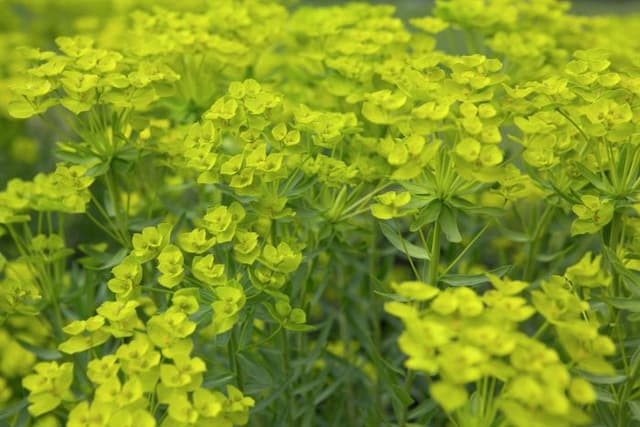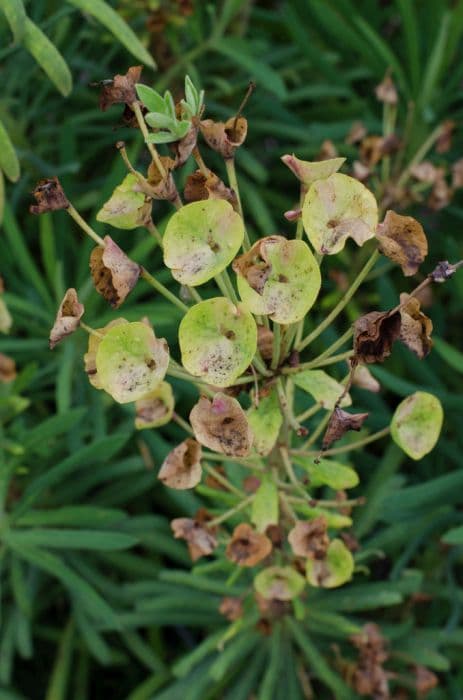Caper Spurge Euphorbia lathyris

ABOUT
Euphorbia lathyris, commonly known as the caper spurge or gopher plant, is a distinctive species characterized by its upright, robust stems which are typically unbranched. These stems hold pairs of large, green, glossy leaves that are oval in shape and arranged in a symmetrical fashion directly opposite each other. The texture of the leaves can be smooth to the touch. What makes this plant particularly noticeable is the pattern the leaves form; they are set in a spiral along the length of the stem, creating an eye-catching geometric appearance. During its blooming period, the caper spurge produces small, inconspicuous yellow-green flowers that cluster at the top of the stems surrounded by showy, leaf-like bracts. These bracts are often mistaken for petals due to their size and location near the flowers. As the plant matures, it develops fruit that resembles a capsule, which upon ripening, may explosively release seeds into the surroundings. The plant's overall demeanor conveys a sort of architectural elegance due to its symmetrical leaf arrangement and columnar growth habit, excluding the dimension of its height and width. The plant exudes a milky sap when cut or broken, which is a characteristic feature of the Euphorbia family. It is important to note that this sap can be irritating to skin and eyes, and therefore care should be taken when handling the plant. The caper spurge is a strong, resilient species that commands attention in the garden or landscape setting with its unique form and foliage, notwithstanding its size or the volume of space it occupies.
About this plant
 Names
NamesFamily
Euphorbiaceae.
Synonyms
Caper Spurge, Paper Spurge, Gopher Plant, Gopher Spurge, Mole Plant.
Common names
Euphorbia lathyris L.
 Toxicity
ToxicityTo humans
Euphorbia lathyris, commonly known as the gopher spurge or mole plant, contains a toxic white latex sap that can cause irritation. If ingested, parts of this plant can lead to symptoms such as nausea, vomiting, and diarrhea. In severe cases, it may cause more serious reactions such as difficulty breathing or swallowing. Contact with skin can result in rash or irritation, and contact with eyes may cause severe pain and possibly temporary blindness. Care should be taken to avoid ingesting any part of this plant and to protect skin and eyes when handling it.
To pets
The gopher spurge is toxic to pets as well due to its white latex sap. If consumed, parts of this plant can cause symptoms similar to those in humans, including vomiting, diarrhea, and potentially more severe reactions depending on the amount ingested and the size of the pet. Oral irritation, pawing at the mouth, drooling, and changes in appetite may be noticed if a pet comes into contact with the sap. Like in humans, skin or eye contact should be avoided as it can cause irritation or other adverse effects in pets.
 Characteristics
CharacteristicsLife cycle
Biennials
Foliage type
Deciduous
Color of leaves
Green
Flower color
Yellow-green
Height
3 feet (91 cm)
Spread
1 foot (30 cm)
Plant type
Herb
Hardiness zones
5-9
Native area
Mediterranean
Benefits
 General Benefits
General Benefits- Ornamental Value: The upright growth and unique appearance of caper spurge add visual interest to gardens and landscapes.
- Pest Control: Caper spurge is believed by some gardeners to repel moles and other rodents due to its toxic properties and strong odor.
- Biofuel Potential: Euphorbia lathyris has been researched as a potential source of biofuel due to its high oil content in the seeds.
- Drought Resistance: This plant is drought-tolerant, making it suitable for xeriscaping and low-water gardens, reducing the need for irrigation.
- Easy Propagation: Caper spurge can be easily propagated from seeds or cuttings, making it a low-maintenance choice for novice gardeners.
 Medical Properties
Medical Properties- Purgative: Euphorbia lathyris has been used historically as a strong laxative due to the presence of compounds that stimulate bowel movements.
- Vermifuge: The plant has been traditionally used to expel parasitic worms from the intestinal tract.
- Diuretic: Some sources indicate that it may promote the excretion of urine, helping in the treatment of edema or water retention.
- Topical irritant: The sap of Euphorbia lathyris can cause skin irritation, which has been used in traditional medicine to create counter-irritation for the purpose of pain relief in certain conditions.
 Air-purifying Qualities
Air-purifying QualitiesThis plant is not specifically known for air purifying qualities.
 Other Uses
Other Uses- Mole Repellent: Euphorbia lathyris is often planted in gardens to deter moles, as they dislike the sap secreted by the plant's roots.
- Natural Barrier: Due to its quick growth and thick foliage, it can be used to create a natural barrier or living fence in a garden setting.
- Ornamental Use: With its striking vertical growth, it serves as an architectural feature in landscapes and gardens.
- Biomass Fuel: The seeds of Euphorbia lathyris have been investigated as a potential source of biofuel due to their high oil content.
- Water Indicator: Traditional use entails planting Euphorbia lathyris to indicate the presence of underground water, as it prefers moist soil.
- Pest Control: The milky sap can act as a natural insecticide against certain types of soft-bodied insects.
- Fish Poison: In some cultures, the sap has been used in small quantities to stun fish, making them easier to catch.
- Gopher Spurge: It is also known by this name due to its reputation for repelling gophers and other rodents.
- Cattle Feed: In certain parts of the world, the plant is used as fodder for livestock, although care must be taken due to its toxic properties.
- Erosion Control: Can be used in soil stabilization projects on slopes to prevent erosion due to its dense root system.
Interesting Facts
 Feng Shui
Feng ShuiThe plant Euphorbia lathyris, commonly known as the mole plant, is not traditionally used in Feng Shui practice.
 Zodiac Sign Compitability
Zodiac Sign CompitabilityThe mole plant is not used in astrology practice.
 Plant Symbolism
Plant Symbolism- Protection: Euphorbia lathyris, commonly known as "caper spurge" or "gopher spurge," is often associated with protection. Historically, it was believed to repel moles and gophers from gardens, symbolizing the safeguarding of one's home from pests or negative influences.
- Purification: The plant has been used in traditional medicine and is thought to carry purifying qualities. It symbolizes the cleansing of an area or person from ill health or negative energies.
- Healing: As caper spurge has medicinal properties, it carries the symbolic meaning of healing. In folklore, it represents recovery and the power of nature to heal physical and emotional wounds.
- Good Fortune: Some cultures believe that caper spurge can bring good luck. Planting it in a garden is thought to bless the household with prosperity and success.
 Water
WaterThe gopher plant, commonly known as Euphorbia lathyris, prefers to be watered when the topsoil feels dry to the touch. This succulent-like plant does not require frequent watering; typically, a deep watering once every one to two weeks is sufficient, depending on the climate and the plant's environment. When watering, it's best to use a method that allows water to reach the roots without wetting the foliage, which can lead to fungal diseases. During the active growing season, in spring and summer, the plant may need more water, around a half to one gallon every two weeks. In winter, reduce the frequency as the plant enters a dormancy period, needing as little as a half gallon once a month.
 Light
LightThe gopher plant thrives in full sun to partial shade conditions. It does best when placed in a location where it can receive at least six hours of direct sunlight daily. However, in extremely hot climates, some afternoon shade can help prevent scorching of the leaves. A south-facing or west-facing spot is usually ideal for providing the gopher plant with the light it needs to grow strong and healthy.
 Temperature
TemperatureThe gopher plant can tolerate a wide range of temperatures but grows best when the temperature is between 60°F and 75°F. It can survive minimum temperatures down to around 20°F; however, it should be protected from frost to prevent damage. It can also withstand high temperatures well above 75°F, but it's crucial to ensure it does not dehydrate in excessive heat. Ideal temperature conditions mimic its native Mediterranean climate, with warm days and cooler nights.
 Pruning
PruningPruning the gopher plant typically involves removing any damaged or diseased leaves and stems to maintain the plant's health and appearance. Pruning can be done as needed throughout the year but is best performed in the late winter or early spring before new growth begins. Overgrown plants can be cut back to their desired size during this time, but always use caution and wear gloves to protect against the plant's toxic sap.
 Cleaning
CleaningAs needed
 Soil
SoilEuphorbia lathyris, commonly known as the caper spurge or mole plant, prefers a well-draining soil mix that is light and airy. A suitable recipe would be one part peat moss or coconut coir, one part perlite or grit, and one part loam or garden soil, ensuring that the mixture doesn't compact easily. The pH level for caper spurge should be neutral to slightly alkaline, between 6.5 to 7.5.
 Repotting
RepottingCaper spurge (Euphorbia lathyris) should be repotted every 2 to 3 years to refresh the soil and provide space for its roots to grow. However, since it can be a short-lived perennial or biennial, it may not require frequent repotting if grown as an annual.
 Humidity & Misting
Humidity & MistingCaper spurge (Euphorbia lathyris) is tolerant of a wide range of humidity levels and does not require high humidity to thrive. Average room humidity or outdoor conditions are typically suitable for this plant.
 Suitable locations
Suitable locationsIndoor
Place caper spurge in bright light, away from pets and children.
Outdoor
Plant caper spurge in full sun to partial shade and well-drained soil.
Hardiness zone
5-9 USDA
 Life cycle
Life cycleEuphorbia lathyris, commonly known as the caper spurge or mole plant, begins its life cycle as a seed, typically dispersed by fruit dehiscence and sometimes by animals. Upon germination, which is favored by warm temperatures and sufficient moisture, it develops a taproot and a rosette of leaves during its first year, establishing itself as a monocarpic biennial. In its second year, a central stem elongates, and the plant transitions to its reproductive stage, bearing small green flowers in umbel-like clusters without petals. After pollination, typically by insects, it produces three-lobed capsules containing seeds. Once the seeds mature, they are ejected from the capsules and the parent plant dies. The seeds can remain dormant in the soil for several years before germinating, continuing the cycle.
 Propogation
PropogationPropogation time
Spring to Summer
The most popular method of propagation for the Euphorbia lathyris, commonly known as the caper spurge or gopher plant, is through its seeds. The best time for sowing seeds is in late winter to early spring. To propagate, seeds should be sown in well-draining soil, preferably in a sunny location. They should be lightly covered with soil – approximately 1/4 inch deep. It's important to keep the soil consistently moist until germination, which typically occurs within 2 to 3 weeks. Once seedlings have established and are large enough to handle, they can be carefully transplanted to their desired location in the garden, where they will grow into mature plants.









